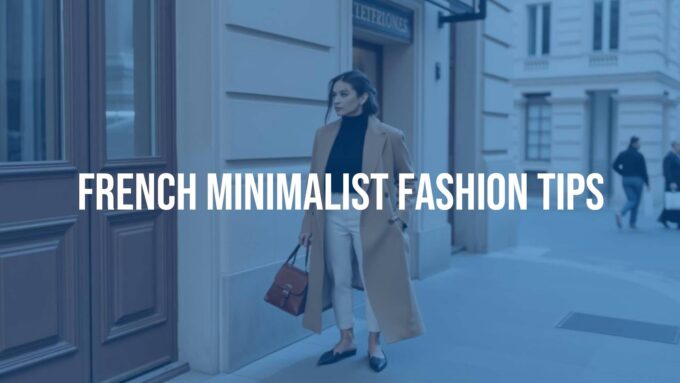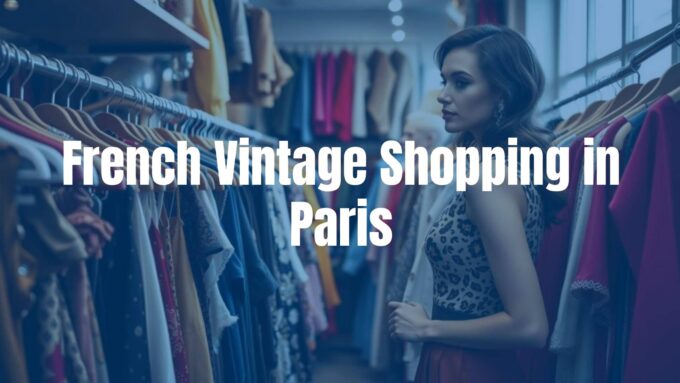French fashion often brings to mind easy elegance and a certain charm that feels hard to explain. Are there real “rules” behind it? Yes and no. There isn’t a strict checklist, but there are clear habits and ideas that guide the look. It’s a mindset about dressing that puts quality, timeless pieces, and quiet confidence first. It’s not about chasing every trend or showing off logos. French style is simple, refined, and personal. In this guide, we explore the main ideas behind French style and share clear tips to bring that feel into your own wardrobe.
What Defines French Fashion Rules?
French fashion is as much about attitude as it is about clothes. It blends confidence, purpose, and an easy touch. Outfits are thought through, yet they never feel forced. The aim is to look neat but relaxed-what many call “chic décontracté.”
The base of this look comes from a few ideas: choose quality, build a strong set of basics, focus on fit, and keep things subtle. Skip the loud, super-trendy items and pick pieces that flatter you over time. The result is a look that feels smart and attractive without trying too hard.

Core Principles of French Style
French style is about careful choice and a love for lasting beauty. Buy fewer, better items instead of piles of fast fashion. True style isn’t about being perfect or wearing every new thing. It’s about knowing yourself and letting that guide what you wear.
You see this in choices like natural fabrics (cotton, linen, silk, wool, cashmere), neutral colors with a few color accents, and pieces that mix easily. Comfort and usefulness matter, so clothes work for daily life as well as looks. In the end, the goal is to look put together and feel at ease.
Parisian Influence on French Fashion Rules
“French fashion” is broad, but Paris has a big influence on how people see it. Parisian style is often seen as a cleaner, more refined take with a minimalist touch. The look is about making a strong impression quietly. Classic cuts and well-made basics do most of the work, with small details and calm confidence finishing the job.
Parisian dressing often means choosing simple pieces with care and pairing them well. You’ll see fewer big logos, more fitted items, and small tweaks-like a neat tuck or a great accessory-that can change the whole outfit. City life also shapes shoe choices: stylish, walkable shoes are a must for cobblestones and busy streets.
Common Misconceptions About French Fashion
There are a lot of myths about French style. One is that French women only wear black. While black is a favorite, the wardrobe isn’t all one color. Color and prints show up as accents, like a bold bag or patterned shoes. Fashion writer Sophie Gachet talks about adding touches like a burgundy bag, leopard loafers, or a neon sweater to brighten a mostly black look.
Another myth: French style is all about luxury brands. Quality matters, but that doesn’t always mean high price. Many mix high and low, shop outlet stores, and buy second-hand. The fabric, cut, and sewing matter more than a big logo. Style coach Aloïs Guinut says that wearing lots of visible brands can come off as trying too hard. The focus is on how a piece feels and fits your style, not the label inside.
French Wardrobe Staples: Must-Have Pieces
A French-style wardrobe comes from a small set of reliable, well-made staples. These pieces don’t go out of style and work together in many ways for daily life and special moments. Investing in these basics helps you build a smart, easy wardrobe that lasts.
| Piece | Why it matters | How to wear |
|---|---|---|
| Trench coat | Classic, practical layer | Over denim, dresses, or suits |
| Striped Breton shirt | Iconic, easy pattern | With jeans, under a blazer |
| Fitted blazer | Sharpens casual looks | With tees, trousers, or dresses |
| Dark classic jeans | Timeless base | With knits, shirts, and flats |
| Ballet flats/loafers | Comfortable and chic | For city walking and work |
| Little black dress | Day-to-night hero | Change shoes and accessories |
The Trench Coat
The trench is a French icon for good reason. It’s practical and polished, perfect for surprise showers in any season. It suits jeans and a striped tee or a dress and heels. Pick a classic khaki or other neutral in a solid fabric with good construction. It will serve you for years.
Striped Breton Shirt
The Breton shirt (“marinière”) moved from navy uniform to fashion staple thanks to Coco Chanel. The blue-and-white stripes go with many looks. Wear it with denim for day, or add a blazer and trousers for something smarter. Long or short sleeves both work-choose a good-quality one for a crisp, lasting finish.
Fitted Blazer
A well-cut blazer bridges casual and dressy. It can turn a tee and jeans into a neat outfit or add structure over a skirt or dress at night. Black and navy are the easiest to use, but tweed or a gentle check can add texture. Fit is key: neither tight nor loose, with clean lines.
Classic Denim
Skip heavy distressing and flashy details. Go for dark or medium washes in straight or slightly wider cuts. Good denim mixes with knitwear, shirts, and blazers again and again. It’s a simple base that keeps things relaxed but still sharp.
Ballet Flats and Loafers
French shoes often blend comfort and style. Ballet flats-made famous in part by Chanel’s two-tone pairs-work with jeans and dresses alike. They’re light and feminine. Loafers are a bit more structured but just as comfortable, and they give a polished finish to many outfits. Both are great for walking around the city without heels.
The Little Black Dress
No French wardrobe feels complete without an LBD. It’s simple, chic, and adaptable. The right one flatters your shape, uses good fabric, and can switch from dinner to events with small changes. Its strength is in its clean look and ease.
Quality Knitwear and Cardigans
When it’s cooler, good knitwear is a must. A strong cardigan (gilet) works hard: over tees or shirts, or even buttoned as a top. Classic shades like black, grey, ecru, and camel pair with almost everything. Fine wool and cashmere sweaters add warmth without bulk and look refined.

1. Prioritize Quality Over Quantity
This may be the most important French rule. A small set of good pieces beats a closet packed with cheap trends. Buy less, choose well, and keep items longer. You’ll get a smarter wardrobe and a more planet-friendly habit.
Quality means good fabrics, solid workmanship, and designs that won’t date quickly. Shop with care, not on impulse. Finance leader and author Nathalie Piegney calls these quality basics “pillars” that must last, chosen with thought, not haste. This approach helps every item earn its place.
Invest in Superior Fabrics and Craftsmanship
French shoppers look at fabric first. Natural materials-cotton, linen, silk, wool, cashmere-feel good, breathe well, and wear nicely over time. Stylist Isabelle Thomas says fabric matters most because it shapes how clothes sit and look. Workmanship counts too: check stitching, seams, buttons, and finish. Good pieces hold their shape and drape well.
This focus includes basics. Even a white tee is chosen for strong cotton and a clean fit, so it stays bright and neat, not limp and worn. This careful eye lifts simple items into favorites you’ll reach for often.
Avoid Fast Fashion Pitfalls
Fast fashion is tempting with its always changing trends and low prices, but it rarely brings lasting joy. What’s hot today can feel tired tomorrow, and that cycle keeps you buying more and loving less.
Instead, shop on purpose. Skip piles of quick buys and pick fewer, better pieces. Aloïs Guinut advises taking your time and going for quality because it lasts and looks better. Even at lower-price stores, choose basics, good fabrics, and solid colors over copycat designs. This approach is better for your style and for the planet.
2. Build a Timeless, Streamlined Wardrobe
The “capsule wardrobe” idea is natural in French style. It means a small set of flexible basics that mix easily and never feel dated. This cuts the “nothing to wear” problem and keeps your closet focused and useful.
Keep your wardrobe in good shape. Replace pieces that wear out or no longer fit you. As Isabelle Thomas notes, our bodies and minds change, and our clothes should follow. Regular edits keep your closet fresh, relevant, and ready to go.
Select Versatile Basics That Mix and Match
Good basics do the heavy lifting: button-up shirts, quality tees, well-fitting jeans, fitted trousers, and simple skirts. Their strength is flexibility. A cotton shirt works with tailored shorts in summer, under a sweater in winter, or under a trench in fall.
Pick basics that are truly timeless. Guinut defines a basic as versatile and “atemporal,” meaning you can’t tell its year. Choose clean lines and simple cuts over trend-heavy details.
Maintain a Curated Color Palette
French wardrobes often lean on neutrals-black, white, navy, grey, camel-with small color pops. This keeps mixing easy and the look polished. Writer Marissa Wu noticed many women wearing all neutrals plus one bright piece for a fun yet calm look.
Use bold colors or prints as accents so they feel intentional. A bright scarf, a colored bag, or one standout piece can add interest without chaos. Aim for harmony so every color feels at home.
Capsule Wardrobe Examples
Picture a base of dark jeans, a crisp white shirt, a black fitted blazer, a striped Breton top, and a trench. Jeans, a Breton, and flats make an easy day look. Swap the Breton for the white shirt, add the blazer and loafers for work. For night, wear the jeans with a silk blouse and the blazer. The trench tops any of these for style and function.
Another set: a black slip dress, a cashmere cardigan, and leather ankle boots. Wear the cardigan open for day, or add a belt, a necklace, and dressier shoes for evening. Small changes keep core pieces fresh.
3. Pay Attention to Fit, Tailoring, and Proportion
Fit is everything. Even pricey clothes fall flat if they don’t fit, while a well-fitted, modestly priced item can look amazing. Careful attention to how fabric sits on your body creates that easy, polished feel.
Getting the right fit often needs a tailor. Adjust sleeves, hems, and waists so lengths and lines are just right. It’s a small cost that pays off, making clothes feel made for you.

Keys to Proper Tailoring
A good tailor can make a big difference. Shorten trouser hems, take in a dress or blazer at the waist, or tweak sleeve length. Aim for clean lines without tightness or bulk. As Victoria Petersen notes, French women skip pieces that don’t fit, no matter how “in” they are.
Think about balance too. If your blazer is slightly oversized, pick slimmer trousers or a fitted skirt to even things out. These choices make outfits look deliberate and flattering.
French Approach to Dress Codes and Occasions
French women have a good feel for what’s right for each setting, and when unsure, they often dress a bit nicer. Activewear stays for the gym. For errands, you’ll see shirts, blouses, and neat tees in neutral shades, often tucked in.
For formal moments, the look stays elegant and low-key, not flashy. A well-fitted dress in a classic color, or smart separates with thoughtful accessories, beats anything loud or revealing. The aim is always neat, appropriate, and calm.
4. Embrace Subtlety: Understated Elegance Matters
French style speaks quietly. It lets quality, fit, and personal taste do the talking, without loud labels or fast fads. This is why it lasts.
“Less is more” guides many choices. Rather than stacking accessories or wearing multiple standout pieces at once, choose one or two items that count. The look stays clear, refined, and timeless.
Why Oversized Logos and Excess Are Avoided
Big logos and heavy branding often feel showy in France. Many see them as a sign of trying to impress rather than having taste. As Guinut suggests, obvious “rich” items can feel off. Focus on the cut, the material, and how the piece makes you feel, not the name on it.
Wearing many visible logos at once is a common mistake. True style shows through design and craft, not a label shouting from your chest. The goal is that you wear the clothes-not the other way around.
Mastering Effortless Chic
“Effortless chic” takes some thought, but it should never look forced. It comes from great fit, good fabrics, a tight color palette, and simple accessories.
A small touch of imperfection helps: a slightly messy hairstyle, an undone cuff, or a well-loved piece. As Carolyn Arentson notes, the look should feel natural, even if it was planned. That relaxed ease lets your personality show, which makes the style more appealing.
5. Use Accessories with Intention
Accessories are chosen on purpose. They add to an outfit rather than drown it. Pick quality over quantity and let each piece have a role.
Often, one or two items do the job-like a silk scarf, a classic leather bag, or well-made shoes. This keeps the look finished but not crowded.
Less Is More: Statement vs. Minimal Accessories
With accessories, French style favors restraint. Instead of many bold items at once, choose one focal point: standout earrings, a special necklace, or a striking bag-just not all together.
The idea is to add interest without clutter. Nathalie Piegney sums it up well: simplicity first. Let the outfit breathe.
Signature French Accessories (Scarves, Bags, Shoes)
Some accessories feel strongly French because they are timeless, useful, and add instant polish.
- Scarves: A silk scarf is a classic. Tie it around your neck, in your hair, or on a bag. It adds color, print, and personality with little effort.
- Bags: Go for long-lasting, simple designs. Many avoid loud branding and choose a structured shoulder bag, a neat tote, or a small clutch. Marissa Wu often saw a “tote + tiny bag” pairing: a stylish handbag plus a plain canvas tote for extra space.
- Shoes: Comfortable, chic shoes matter. Ballet flats and loafers work for daily life. For dressy times, pick a classic pump or clean sandal. The right shoes can finish a look perfectly.

These accessories aren’t just add-ons. They are key parts of the French look, chosen because they add style without stealing the show.
6. Balance Trends and Personal Style
Handling trends while keeping your own style is a skill French women do well. They filter trends through their taste, keeping only what fits their wardrobe and their body. This keeps their look honest and lasting, not a mirror of the latest hype.
The trick is knowing what suits you. They pick small trend touches that work with their basics, adding a current feel while keeping their base steady. This balance matters for a style that feels both fresh and personal.
How French Women Approach Trends
Trends aren’t ignored, but they’re used lightly. Sophie Gachet says the Parisienne sticks to her style but may add a few trend notes to refresh it. Think a new color through an accessory, or a modern shape in a classic fabric-not a trend from head to toe.
Guinut buys trend pieces only if she truly loves them and sees herself wearing them years later. She avoids items that spread fast and clearly mark a specific season. Trends should whisper, not shout.
Finding and Owning Your Signature Style
French dressing starts with knowing yourself. What colors flatter you? What cuts suit your shape? What feels like you? As Piegney says, buy what flatters you-not just a brand.
Build your “own basics.” For one person, a trench is key; for another, it might be a jean jacket. Keep moderation in mind and aim for a natural feel. When your clothes match your taste and life, your style feels real-and that’s the French way.
7. Dress with Confidence and Authenticity
The secret ingredient is confidence. Clothes help tell your story, but how you wear them makes all the difference. This is not about ego. It’s about quiet self-belief.
Confidence lets you choose what feels right for you, not what others expect. It’s comfort in your skin and ease in your choices. Even simple outfits look elevated when worn with self-assurance.
The Role of Self-Assurance in French Style
Self-belief lifts any look. It often comes from knowing your style, skipping blind trend-following, and dressing for yourself. As Natalie Dixon puts it, confidence is key in French style-show it, and your whole look rises.
This isn’t about seeking attention. It’s a calm certainty that shows in posture, expression, and presence. Wear what makes you feel good, and it will show.
Embracing Imperfection and Individuality
French style welcomes imperfection and individuality. Flaws add character. Many care for skin, hair, and nails, but they also see smile lines as part of real beauty. If cosmetic work is considered, it’s done lightly to keep natural traits.
This ease shows up in outfits too. They don’t chase an impossible ideal. A look can be a bit relaxed and still feel true. There isn’t one “French look.” The same ideas show up in many personal ways.
Practical Tips for Integrating French Fashion Rules
Bringing French style into daily life can feel overwhelming, but it’s very doable with a few small changes. You don’t need to copy; just apply the main ideas in a way that fits you. Build a strong base, be intentional, and enjoy getting dressed.
Creating Simple Outfit Combinations
Start with easy outfit formulas. A good pair of dark jeans, a crisp white shirt, and a fitted blazer can be a base. Switch shoes and add one key accessory to change the mood.
Mix and match your staples. A Breton top with jeans for day; tuck it into trousers with loafers for a sharper look. Aim for pieces that pair well so you get many outfits from a few items.
Shopping Smart: What to Look For
Shop for the long run. Choose natural fabrics-cotton, linen, wool, cashmere, silk. Check seams, stitching, and buttons. A good piece feels sturdy and looks clean inside and out.
Pick classic shapes over quick trends. A fitted trench, a clean blazer, or a simple dress will work for years. Look at second-hand shops or outlets, too. Focus on fit and feeling, not just brand names. As Isabelle Thomas warns, buying a name doesn’t always buy style.
Adapting French Rules to Personal Taste and Lifestyle
These tips are flexible. Shape them to fit your life and your taste. If you dress casually most days, upgrade your basics: strong tees, neat jeans, and clean sneakers like Stan Smiths or Vejas. If you love bold looks, use color or print as accents, not head-to-toe.
Find the basics that suit you. Maybe your go-to layer is a denim jacket, not a trench. Stick with quality, good fit, and a calm feel. Your version of French style should feel like you.
Questions About French Fashion Rules
People often wonder how to apply these ideas: Do you need French brands? Can you blend styles? What should you avoid? Here are clear answers.
Should You Buy Only French Brands to Dress French?
No. French style is a mindset, not a passport. Focus on quality, fit, and timeless designs, wherever they come from. Many French women mix brands from everywhere. Look for good fabric and cut, and choose pieces that flatter you. As Piegney says, buy what makes you look and feel your best.
Can You Mix French Style with Other Influences?
Yes. French style is a flexible base. Keep the core-quality, good fit, and quiet polish-and add touches from other looks. Try a classic blazer with a boho skirt, or French basics with Scandi minimal pieces. Stylist Isabelle Thomas supports mixing old and new, expensive and affordable, simple and bold. Make the mix feel balanced and intentional.
What Are Common Mistakes to Avoid?
There are a few traps to skip:
- Over-accessorizing: pick one or two key pieces, not a pile.
- Big logos: let design and quality speak instead.
- Chasing every trend: add small touches only if they fit your style.
- Poor fit: even great pieces look off if they don’t fit well.
- Trying too hard: heavy makeup and overly “done” hair can break the easy look. Keep it natural.
The aim is always to look effortlessly chic, not overly polished or fussy.












Leave a comment